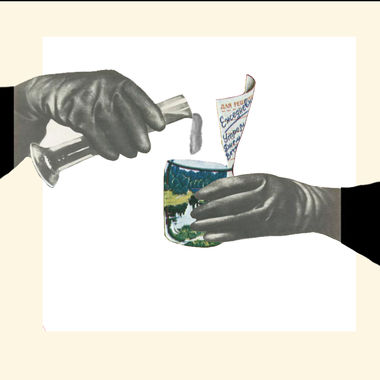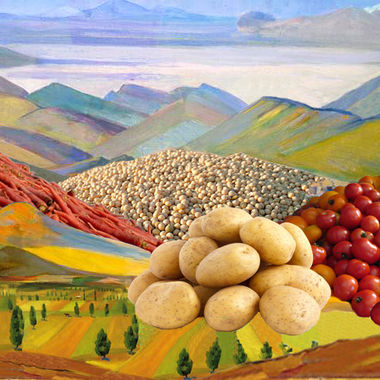Thu Feb 28 2019 · 11 min read
Why Haven’t You Registered? Armenia’s Problem of Illegal Garbage Dumps

By Gevorg Mnatsakanyan
With over 300 unregulated garbage dumps in the country and not a single legally licensed sanitary landfill to replace them, it’s a wonder Armenia hasn’t drowned in a sea of trash. A wave of European financed projects backed by a reinvigorated government are now determined to offset this trend.
Such abundance of illegal dumps in the country – not to be confused with sanitary landfills that require proper infrastructure and management to comply with strict environmental standards – is the result of poorly formulated and often ignored waste management policies. The 500,000 dram (approximately $1,000 US) landfill registration fee that includes the costs of a compulsory environmental impact assessment by the Ministry of Nature Protection, as well as the frequent absence of legally defined areas for waste disposal and of proper waste collection equipment have all done little in the way of incentivizing local communities to go legal when it comes to dumping their garbage.
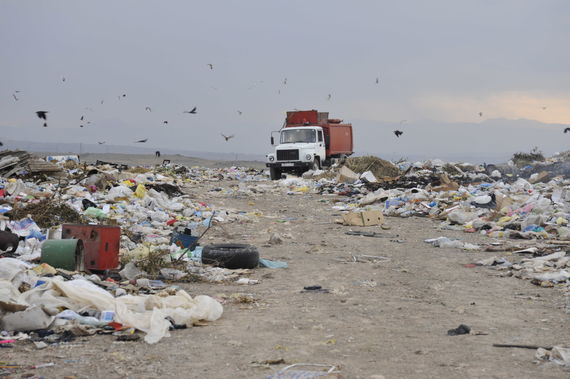
Garbage dump near the city of Etchmiatzin in Armenia. Photographs by Sara Anjargolian from a larger body of work entitled, "How We Live."
Irina Ghaplanyan, First Deputy Minister of Nature Protection says that most landfills in Armenia are created arbitrarily without proper environmental assessment of the chosen territory and little to no technical oversight. “It is no surprise then that none of the country’s dumps are in line with international environmental standards. A fact that is of equal concern for the environment and those living in the vicinity of these dumps,” she explains.
The country’s inadequate waste collection and management practices have also been fraught with financial implications. In 2017 alone, land degradation, in part attributable to poor waste management, cost Armenia an estimated $71 million – 0.6 percent of total GDP, according to a United Nations Convention to Combat Desertification report.
An Institute for Health Metrics and Evaluation Global Burden of Disease study also estimated that the underperformance of environmental policies because of the authorities’ failure to implement many of their own legal provisions on landfills and other environmentally sensitive issues translated into total environmental health loss costs of $175 million in 2016.
Like many of Armenia’s current issues, random trash disposal has its origins in the country’s post-Soviet era. In Soviet times, the service and delivery of utilities was, like much else, centralized. With independence, responsibility for providing basic services like waste collection fell to the newly-formed local self-governing bodies, who, especially in the regions, were both legally and materially (machinery/equipment) unprepared for the task. These shortcomings are the root cause of Armenia’s present waste problem since all but two dumpsites in the capital’s Nubarashen and Ajapnyak districts are located in rural areas.
The Armenian government has since taken incremental steps towards improving the laws governing waste management in the country. In 2004, it passed a law on waste that addressed most shortcomings of the past by specifying, in particular, the rights and responsibilities of state and local authorities in managing waste within their purview. Director of the American University of Armenia’s Acopian Center for the Environment Alen Amirkhanian says an additional 29 sub-legislative acts have topped up the law since its adoption.
According to the law, both regional and local/community authorities can now liquidate illegal dumpsites, though neither the method nor the procedure for this operation has yet been specified. The law also requires dumpsites to be approved by both Ministries of Health and Nature Protection to guarantee the health and welfare of nearby residents and prevent contamination of the ambient air and soil, as well as underground waters.
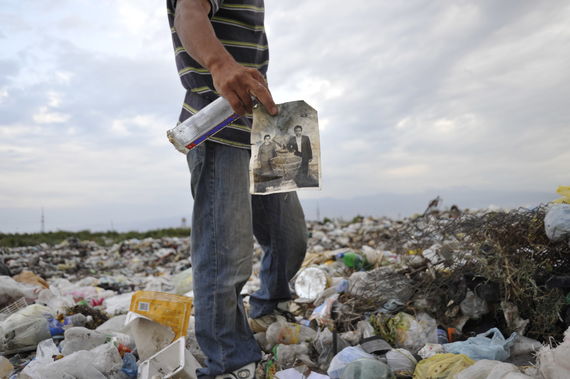
A 2006 governmental decision also requires “legal entities,” which includes (though only implicitly) local self-governing bodies, and “individual entrepreneurs” to register their dumps with the Ministry of Nature Protection. Only 92 dumps – out of more than 2,000 before the Ministry of Territorial Administration and Development’s great clean-up operation in October 2018 in the framework of its Clean Armenia initiative saw the closing of just under 1,700 dumps – had been added to the Ministry’s register since the adoption of the decision. Legal reforms under the country’s new leadership are now targeting local authorities more directly to make sure all register their dumps accordingly.
But despite the government’s best efforts, “the legal system is still flawed,” says Harutyun Alpetyan, Circular Economy Expert at the Acopian Center for the Environment. “Many communities have no other choice but to use spontaneously formed dumpsites simply because there isn’t a legally defined area within the community for waste disposal, which is only made worse by the lack of equipment for proper waste collection.”
The high-priced and complex bureaucratic procedure for registering a landfill, coupled with low dumping taxes have only added to the issue of illegal dumps in the country. The current landfill tax levies little more than 1,000 Armenian drams per cubic meter of waste dumped on local waste collection companies like Sanitek. In developed countries like Germany or Sweden, dumping the same amount of waste into a landfill, also known as landfilling, costs operators up to 200 euros – a hundredfold expense compared to Armenia. No wonder then that none of the local communities in Armenia are willing to spend 500,000 drams to register their landfills when disposing of waste is so cheap.
“But increase the cost of dumping,” says Alpetyan, “and many will think twice before throwing something in the trash.” He explains that the objective of increased taxation is not to overburden local communities with more spending. Rather, it is part of a larger concept of circular economy that aims to prevent or – to the very least – reduce, reuse and recycle waste generated along both production and consumption lines instead of directing efforts at managing already existing waste. “Pioneering countries like Germany and Denmark have since long applied this reduce, reuse, recycle – the 3R-scheme to manage waste within their communities,” says Alpetyan, “thanks to which landfills are now a thing of the past.”
In January 2018, the European Commission also adopted a series of measures known as the 2018 Circular Economy Package “as part of its continuous effort to transform Europe's economy into a more sustainable one.” And while Armenia is still very far from implementing a circular economy-based waste management scheme, “the positive preconditions are there for Armenia to succeed if we can devise a viable, feasible and sustainable enough waste management strategy for the entire country,” says First Deputy Minister Ghaplanyan.
While experts like Alpetyan and his Swedish counterparts are looking to develop a national solid waste governance policy based on the principles of circular economy with the Waste Governance in Armenia project, the government has amended the Law on Waste Management and Sanitary Cleaning to increase the waste collection fee paid by residents from its initial minimum of zero to a minimum of 50 drams.
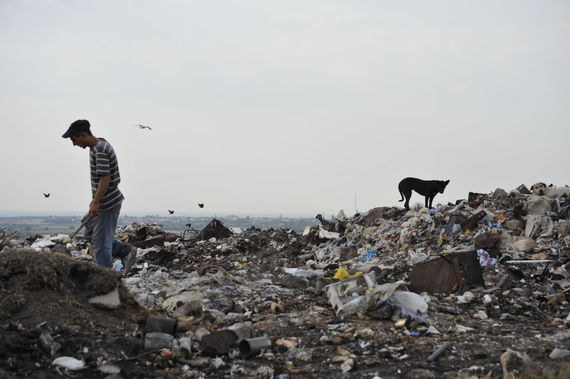
Prior to the revision of the law, “some community leaders chose not to collect waste collection fees from their constituents because they didn’t want to lose their political supporters in the next elections or offend relatives within these constituents,” says Narine Avetyan, head of the Department of Territorial Infrastructure Development at the Ministry of Territorial Administration and Development. The objective, according to Avetyan, is to transition to a self-sufficient system of waste management within communities whereby each community will be able to cover its own waste management expenses.
Other than the financial aspect, the country’s legislation is sometimes unclear about the responsibilities of different governmental bodies with regards to waste management, not least because of the dizzying array of laws, directives and orders that govern the field in Armenia.
According to the charter of the Ministry of Territorial Administration and Development, waste management in Armenia falls under its jurisdiction, while the Law on Waste holds the Ministry of Nature Protection responsible for handling hazardous waste. “But since most of the household waste generated by local communities isn’t sorted,” says First Deputy Minister Ghaplanyan, “it is considered fourth degree hazardous waste and so must be dealt with by the Ministry of Nature Protection despite it still being, essentially, household waste.”
An intergovernmental working group formed by prime ministerial decree of Nikol Pashinyan in October 2018 now brings together representatives from the Ministry of Territorial Administration and Development, the Ministry of Nature Protection, the Ministry of Education and Science, but also the Police and other governmental institutions to clarify the responsibilities of each and offer systematized solutions to the issue of waste management that include educating and involving greater swathes of society.
The working group is also determined to resolve the lack of effort coordination between government and local and foreign private companies. “Hordes of international organizations have conducted countless feasibility studies but none seem to lead to a systematic, unified national waste management strategy,” says Avetyan. “I believe that the intergovernmental working group is an effective solution to this problem.”
Other institutional reforms, the government, together with different European financial institutions, is pursuing two major sanitary landfill construction projects at the current site of the Nubarashen dump in Yerevan and in the nearby town of Hrazdan to further tackle its waste management issues.
The first of such initiatives – the Yerevan Solid Waste Project – was initiated back in 2014 under the leadership of then Mayor Taron Margaryan. Alive and well under the Municipality’s post-Velvet Revolution administration, the project looks to liquidate two of the city’s main dumpsites in Nubarashen – the largest in Armenia with a total surface area of 50 hectares – and Ajapnyak and replace those with a new, EU compliant landfill near the current site of the Nubarashen dump. Estimated at 25.4 million euros, the project counts 8 million euros in loans from the European Bank for Reconstruction and Development (at 2.5-3.5 percent depending on current LIBOR interest rates), 8 million euros in loans from the European Investment Bank (at 1.4 percent) and 8 million in grants from the EU Neighbourhood Investment Facility.
Yerevan Municipality and the European banks say that the project will benefit public health and environmental sustainability, as well as those 200-plus people whose livelihood depends on the site. The Municipality is also looking to produce 1.4 megawatts worth of electricity per year through waste incineration, according to First Deputy Mayor of Yerevan Hrachya Sargsyan.
But with Armenia’s gross external debt exceeding $6 billion US, new loans from European banks will likely deteriorate the country’s already bloated debt profile. “The government should not be looking into spending credited money on building a landfill with a mere 28-year lifespan in the 21st century,” says Irina Ghaplanyan. With an evolving global vision for waste management and more sustainable alternatives available, Ghaplanyan says that taking loans and burdening the Armenian taxpayer is simply unjustified.
A belief shared by Michael Aloyan, founding manager of Westtech, a new Armenian-American waste management company set to operate in Armenia and Russia. “Projects like the Yerevan Solid Waste Project are not sound business,” Aloyan explains. “They are the kind of investment that is doomed to fail because of its unsustainability and become a burden on the state and its citizens.”
Aloyan, whose experience in waste management spans 25 years, is single-handedly responsible for liquidating the 50-year-old dump in Garni within 28 days thanks to a patented enzyme that feeds on organic waste while leaving behind reusable raw materials like aluminum and glass. The Armenian-American entrepreneur is now proposing to clean up the Nubarashen dump within six months and transform the area into a resort for $5 million instead of the almost 26 million euros provided by the European lending institutions. For an additional $750,000, Aloyan is also prepared to liquidate the large dump in Ajapnyak – the second largest in use in Yerevan.
“The problem with the Yerevan Solid Waste Project,” says Aloyan, “is that it doesn’t mean to get rid of the thousands of tons of waste and all the harmful elements like diseases and hazardous trash that have accumulated in Nubarashen over the years. It only looks to cover the waste with a plastic film and then a layer of soil, which is basically like covering cancer with a bandage.” With his $5 million plan, Aloyan promises to eliminate all surface and recently buried waste and decontaminate the underlying soil to reduce the dump’s mass by 30-40 percent and allow for its continued use.
But First Deputy Mayor Sargsyan, insists that the capital needs a new landfill: “The Nubarashen dumpsite has been used to dispose of all waste in Yerevan since the 1950s without appropriate regulation and although there are no reports to evaluate its impact on the health of nearby residents and the environment, it’s clear that its impact must have been negative.”
Nicholas El Tawil, whose company – Sanitek – enjoys a monopoly over waste collection in Yerevan, agrees that the implementation of the Yerevan Solid Waste Project is “for the time being the quickest and best solution” to the city’s current waste problem given the complete lack of management and generally “disastrous” situation at Nubarashen.
Addressing concerns over the financial sustainability of the project, Sargsyan says that “we must first understand the dollar value of the damages caused by the present dump to the environment and the health of nearby residents” before rushing to conclusions about the potential burden on taxpayers of the 16 million euros intended for the new landfill, while admitting that the precise value of these damages is today unknown. “But we can safely assume that the waste accumulated over the past 70 years must have caused great financial damages,” says Sargsyan.
Other than its financial downside, the project has also been criticized by environmental activists for failing to incorporate a sorting and recycling component into its waste management process. Sargsyan explains that recycling is a business activity of which the Municipality cannot partake, though it may sort its waste and sell the obtained raw materials, such as paper and plastic, to a third party for renewed use. “Although sorting doesn’t solve the greater issue of waste,” says Sargsyan, “the inclusion of sorting facilities in future landfills will no doubt extend the lifespan of these landfills since only 30-40 percent of the total waste generated by the city will be sent there after sorting.”
According to Sargsyan, the Municipality is now looking to save up some of the money provided by its European creditors to invest in a sorting facility in a completely new landfill, though he fails to specify where the landfill will be located, nor when it is due. Unofficially, the facility is estimated to cost between $1.5-2 million US.
The environment on EVN Report
Why Green Policies Are Not Green For Everyone
By Sofia Manukyan
Cross-border cooperation among environmental groups is imperative to ensure real environmental protection globally. Drawing examples from Armenia and Lebanon, Sophia Manukyan delves into the world of high-stake investments and assistance in heavy metal mining and waste management.
Reforming the Armenian Mining Sector: Civil Society Stands Up to Be Heard
By Varant Meguerditchian
Mining has a potential to play a significant role in Armenia, however current gaps in legislation and poor monitoring and assessment presents many risks.
Environmental Protection and Pandora’s Box to Independence
By Ani Garibyan
Even after Armenia gained independence from the Soviet Union, it is still reliant on many Soviet-built (sometimes very poorly built) infrastructure that can prove to be dangerous to local communities, flora and fauna, as well as the country’s economy and national security.
Global Pressures or Lack of Vision? Armenia in GMO Limbo
By EVN Report
Today, the demand for increased agricultural productivity to ensure food security, the use of genetically engineered crops and powerful conglomerates that control most of the world’s seed industry like Monsanto are threatening the lives and livelihoods of small farmers all over the world. This contentious global debate has now found its way to Armenia. EVN Report investigates.
Here again, Aloyan disagrees with the Municipality’s logic: “Everyone is saying that Yerevan needs a waste sorting plant. The problem is that waste in Armenia is very poor with only 5-7 percent of it subject to sorting, which isn’t enough for a plant like that to cover its expenses.”
In the grand scheme of things, the Yerevan Solid Waste Project is part of the “2017-2036 Solid Waste Management System Development Strategy of the Republic of Armenia,” which, although developed under the former government and ratified back in December 2016, is the strategy that the new government is now using to tackle the issue of unlicensed dumpsites on a national scale for the next 20 years.
The strategy is based on an earlier waste management plan developed by the Government of Armenia together with the Asian Development Bank back in 2013 that was later beefed up by the Ministry of Territorial Administration and Development’s 2017 Clean Armenia Action Plan and aims to build either six or nine large sanitary landfills across Armenia where each landfill will service a designated region. The Nubarashen landfill, the largest of the group with its 300,000-ton waste intake capacity, will service Yerevan and the neighboring regions of Armavir, Ararat, Vayots Dzor and Aragatsotn. EU compliant, these new landfills hope to reduce the number of illegal dumps in the logic of “all for one, one for all” by regrouping individual dumps into one controlled landfill.
Although the strategy is the latest major effort of the government to tackle the country’s rampant waste management problem, some in the field like First Deputy Minister Ghaplanyan have questioned its cost efficiency on account of the long-distance transporting of trash under the proposed landfill distribution plan.
And with public environmental spending averaging at less than 0.2 percent of GDP between 2012 and 2016 compared to Europe’s 0.7 percent average despite ranking fourth most vulnerable country in the region to climate change, Armenia’s government will have to demonstrate strong will if it is to overcome the pressing issue of illegal dumps.

